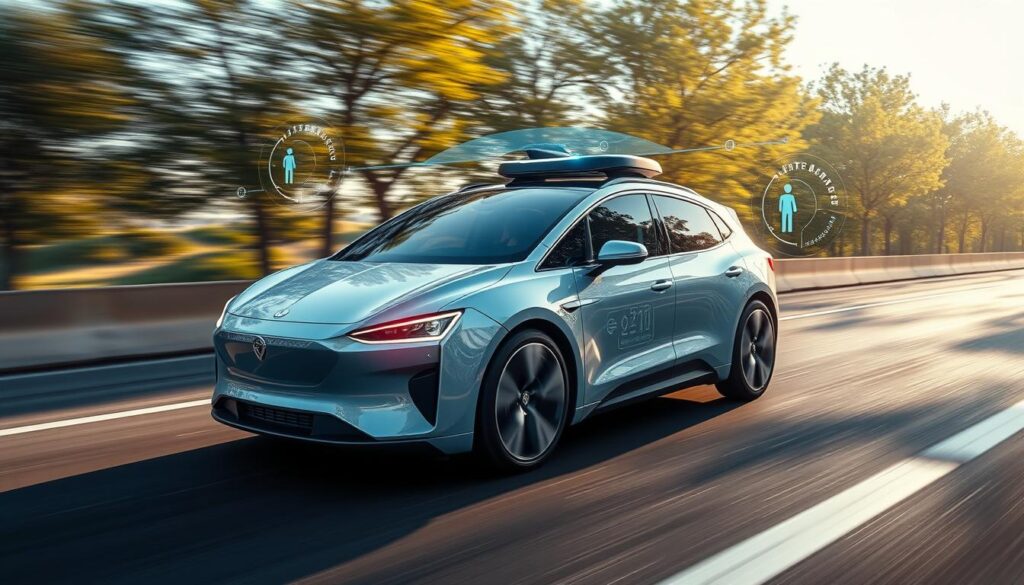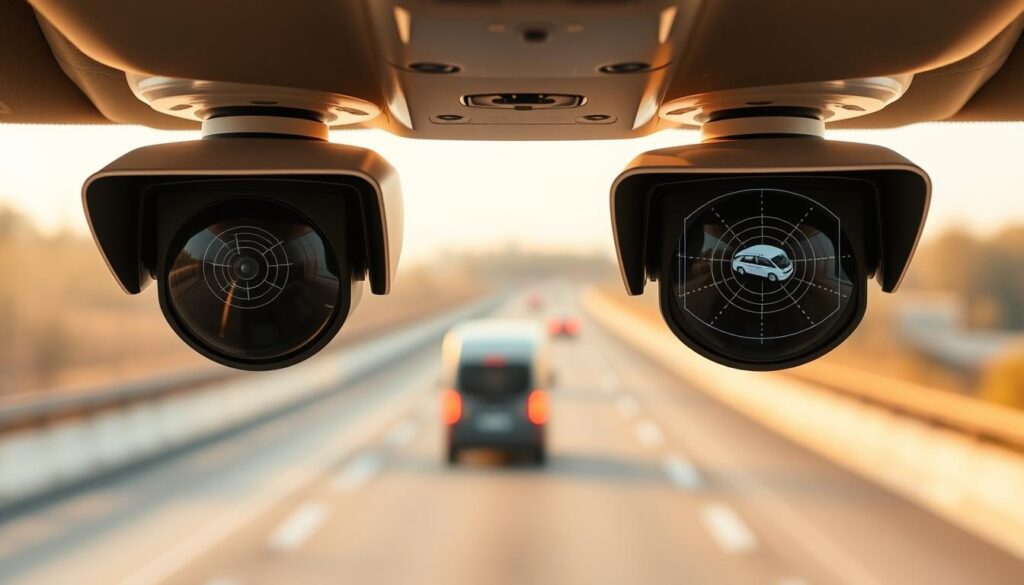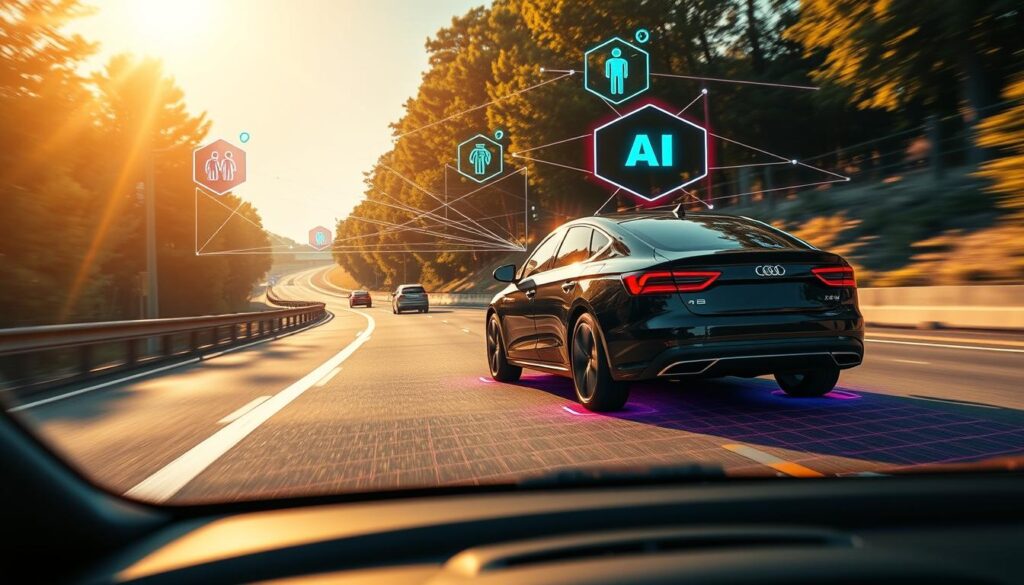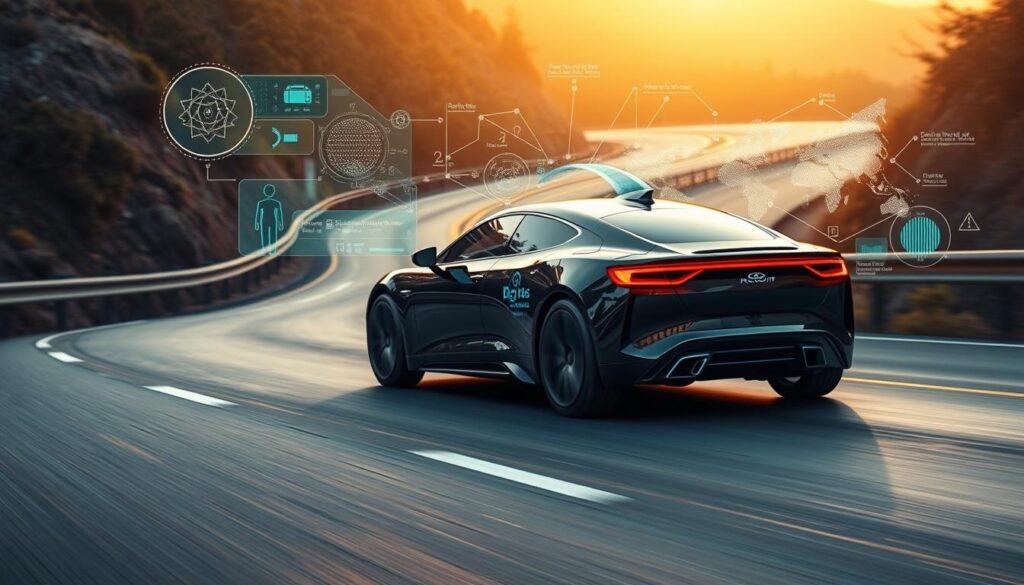On a rainy Tuesday, a commuter watched a car ahead brake gently as a cyclist swerved. The scene felt ordinary until the driver later learned the car used an advanced system that fused camera, radar, and lidar data to act in an instant.
That quick response shows how artificial intelligence helps vehicles perceive the world, plan paths, and assess risk. These systems turn raw sensor input into a clear 3D model so a car can choose the best action in fractions of a second.
In this article, we preview seven key safety systems, from object detection and behavior prediction to ethical decision support and fail‑safe control that hands off to a human if needed. Supporting tech like HD maps, 5G links, and GPU accelerators shrink response times and enable continuous updates.
There is huge promise for smoother traffic, fewer crashes, and more reliable transportation. Yet limits remain: bad weather, mapping gaps, and cyber threats demand careful design and oversight. A safety‑first approach is the only way to earn trust as this revolution moves forward.

Key Takeaways
- Artificial intelligence fuses sensors into a 3D model for fast decisions.
- Seven systems—from detection to fail‑safe control—shape modern cars.
- HD maps, 5G, and GPUs cut latency and enable smarter updates.
- Challenges include weather, coverage gaps, and cybersecurity risks.
- Safety‑first design builds public trust and advances the future of transportation.
Why Safety Is the True North for Self‑Driving Cars in 2025
By 2025, public confidence in automated transport hinges on one thing above all: demonstrable reduction in crashes on the road.
Over 1.35 million people die in road crashes each year, mostly from human error. Modern systems use artificial intelligence to keep constant attention, enforce safe gaps, and react faster than distracted or impaired drivers.
Yet high‑profile incidents remind us that technology alone is not enough. The 2018 Uber fatal crash underlined the need for redundant systems, rigorous software validation, and vigilant driver monitoring for safe handoffs.
Companies now rely on large‑scale simulation, shadow‑mode testing, and staged rollouts to validate performance. Robust incident data collection and transparent reporting build trust with regulators and the public.
- Design and oversight: safety must guide every decision.
- Operational readiness: trained drivers and monitoring keep transitions safe.
- System resilience: secure connectivity and authenticated updates matter.
Improvement is continuous: fleets learn from diverse conditions, ethical guardrails are debated publicly, and industry, academia, and governments align on traffic rules and benchmarks.

“Reducing harm on our streets is the only acceptable metric for progress.”
Understanding the Building Blocks: From Sensors to Decisions
Perception and fusion layers form the backbone that lets machines understand complex traffic scenes. These elements turn raw inputs into a shared picture the control stack can act on.
Computer vision for environmental perception
High‑resolution cameras plus deep neural networks label pixels as cars, pedestrians, cyclists, signs, and lights. Models trained on vast, diverse data sets enable robust detection in day, night, rain, or snow.
Machine learning improves recognition over time as fleets add edge cases. Compute accelerators run inference on board so perception stays fast and local.

Sensor fusion to create a 3D world model
Radar, lidar, ultrasonic, and camera feeds are fused to overcome single‑sensor limits. The result is a continuous 3D map aligned to HD maps for centimeter‑level localization.
Algorithms feed that world model into prediction, planning, and control so the system obeys traffic rules and prioritizes safe maneuvers. If some sensors degrade, fail‑safe modes favor the most reliable inputs to keep performance graceful.
- Perception → Prediction → Planning → Control is the pipeline that turns understanding into action.
- Continuous updates refine models as new fleet data improves edge case coverage.
The Top Seven AI Safety Systems Powering Autonomous Vehicles
A layered set of technologies turns sensor data into split‑second decisions that reduce crash risk.
Below are the seven core systems and how they interlock to deliver robust, end‑to‑end autonomy focused on avoiding collisions and obeying traffic rules.

Object detection and classification
Deep learning models label pedestrians, cars, bikes, and signs with high accuracy. Models improve as fleets add edge cases and new datasets.
Behavior prediction
Prediction models estimate paths for pedestrians, cyclists, and other vehicles. Anticipating a sudden swerve or a jaywalk buys critical reaction time.
Anomaly and hazard detection
Specialized detectors flag unusual obstacles or erratic actors. When anomalies appear, the stack slows or reroutes to reduce risk.
Motion and path planning
Planners respect right‑of‑way, speed limits, and safe gaps while optimizing comfort and efficiency. They translate intent into smooth, lawful maneuvers.
Navigation and localization with HD maps
Map‑anchored localization gives lane‑level position and context for precise turns, merges, and complex intersections.
Real‑time risk assessment and ethical decision support
Risk modules score trade‑offs in split seconds, prioritizing human safety and legal compliance when options conflict.
Redundancy and fail‑safe control
Multiple sensors, backup compute, and graceful degradation protect performance under faults. Safe‑stop protocols and human handoff procedures complete the chain.
| System | Primary Role | Key Benefit | Validation |
|---|---|---|---|
| Object detection | Perception | High‑accuracy identification across scenes | Large annotated datasets and on‑road tests |
| Behavior prediction | Forecasting | Early anticipation of actor actions | Scenario simulations and real traces |
| Anomaly detection | Alerting | Detects rare or unexpected hazards | Edge‑case mining and synthetic tests |
| Motion planning | Trajectory generation | Lawful, smooth maneuvers with safe gaps | Rule‑compliance checks and closed‑loop sims |
| HD map localization | Positioning | Centimeter‑level lane context | Map maintenance and field validation |
| Risk & ethical support | Decision scoring | Human‑centered trade‑off handling | Policy reviews and stakeholder audits |
| Redundancy & fail‑safe | Resilience | Graceful degradation and safe handoffs | Fault injection and backup testing |
AI autonomous driving safety, IoT vehicle monitoring, self-driving prevention.
Edge sensors and networked alerts let modern stacks spot trouble ahead and respond before small issues grow.
Telematics and V2X feeds stream status, location, and hazard warnings from cars to edge and cloud systems. That flow creates real‑time alerts for roadside risks, component faults, or route hazards.
When a sensor flags a sudden brake or tire anomaly, the platform can nudge a nearby car to slow, change lanes, or stop if a risk threshold is met. These nudges cut reaction time and reduce escalation.
Fleets deliver continuous insights that refine models and lower false positives. Over time, shared data sharpens prediction and improves uptime through predictive maintenance.

- Practical solutions: telematics diagnostics, V2X work‑zone warnings, and over‑the‑air policy pushes.
- Operational tools: dashboards for triage, quick policy updates, and operator visibility across assets.
- Trust tech: blockchain can lock decision logs and OTA history to aid audits and transparency.
| Layer | Function | Benefit |
|---|---|---|
| Edge sensors | Local status and hazard detection | Millisecond alerts, immediate action |
| Cloud analytics | Aggregate insights and model updates | Better prediction, fewer false alarms |
| Connectivity (V2X) | Roadside and fleet messaging | Proactive reroutes and warnings |
“Privacy‑by‑design keeps personal data minimal while teams gain actionable insights.”
ROI is clear: fewer roadside events, lower repair bills, and higher uptime for fleets. Automakers can deploy these layers today to reduce risk and improve operations.
IoT Vehicle Monitoring: From Edge Sensors to Cloud Insights
Edge sensors stream condition data while cloud tools turn those feeds into actionable fleet plans.
Telematics streams for health and status
Telematics devices collect engine, battery, brake, and tire metrics in real time. That raw data flags anomalies before they grow into road hazards.
With 5G, cars receive OTA updates, live traffic, and V2X messages that shorten response time. Cloud analytics then aggregate streams so fleet teams can predict failures and schedule repairs.

V2X messaging to anticipate road events
V2X warns of sudden slowdowns, emergency vehicles, work zones, and signal phase/timing at intersections. Edge processing filters noise and ensures critical alerts propagate instantly.
Standard APIs let companies scale multi‑vendor deployments and integrate with shop systems to auto-order parts and book service, boosting efficiency and uptime.
- Security: encrypted links and signed firmware for telematics units.
- Cloud management: predictive maintenance, routing, and fault analytics.
- KPIs: fault trends, intervention rate, mean time between failures, compliance score.
| Layer | Function | Benefit |
|---|---|---|
| Edge | Sensor fusion & filtering | Low latency alerts |
| Cloud | Aggregation & analytics | Actionable maintenance |
| Network | 5G & V2X | Faster sync and OTA updates |
Result: better-prepared cars, fewer surprises on the road, and smoother trips for passengers and fleet operators alike.
Self‑Driving Prevention Technologies That Avert Crashes Before They Happen
Systems that spot risk before it becomes a crash are changing how cars share the road.
Proactive collision prediction and avoidance
Collision detection analyzes surrounding motion, road geometry, and intent cues to score risk in real time.
Predictive models fuse trajectories, map context, and subtle intent signals from nearby drivers and pedestrians. When scores cross thresholds, the control stack can apply early braking, make a gentle lane shift, or reroute around a blockage.
Continuous learning from near‑misses refines thresholds so interventions fall only when needed. Comfort calibration keeps maneuvers smooth to maintain passenger trust.
- V2X alerts reveal hidden hazards beyond line of sight and boost onboard forecasts.
- Transparent logs record decisions for post‑event analysis and model tuning.
- Redundant sensors keep prevention robust in poor weather or partial occlusion.
| Function | Benefit | Metric |
|---|---|---|
| Risk scoring | Faster, principled decisions | Lower reaction time |
| Proactive maneuvers | Smoother avoidance | Fewer abrupt brakes |
| Policy prioritization | Human safety first | Reduced crash rates |
“Prevention tech turns seconds of foresight into measurable drops in collisions and claims.”
High‑Definition Mapping and Continuous Localization for Safer Autonomy
Rich map layers — lane edges, stop bars, and signal positions — make decisions less ambiguous at merges.
HD maps enriched by lidar and camera runs provide centimeter-level detail for lane markings, curbs, and signage. That lane‑level context—stop lines, guardrails, and signal locations—helps planners predict intent and make maneuvers more predictable for other road users.
Localization aligns onboard sensors and perception patterns to map features to reach centimeter accuracy. Redundant inputs—GNSS, visual landmarks from cameras, and inertial sensors—keep position reliable in urban canyons and tunnels.
Continuous map maintenance loops detect change, validate edits, and push OTA updates over 5G so fleets stay synchronized. When maps are stale or missing, systems fall back to onboard perception and adopt conservative speed and gap policies.
- Map confidence scores feed planners to adjust speed and following distance when uncertainty is high.
- Better map fidelity reduces ambiguous choices at merges and unprotected turns, improving comfort and performance.
- Privacy and security matter: encrypted map storage and authenticated updates protect sensitive map and localization data.
“Investing in mapping yields fewer route errors and smoother trajectories for cars on complex roads.”
Onboard Compute, 5G, and Edge AI: Enablers of Split‑Second Safety Decisions
Low‑latency compute and links are the backbone that turns sensor data into timely control.
Modern automotive platforms use multicore computers with GPU accelerators to run perception and planning at video frame rates. That compute lets models spot hazards and plan maneuvers in the time available before an incident.
GPU and accelerator platforms for real‑time inference
GPUs and dedicated accelerators process camera, radar, and lidar streams on the car. This on‑board execution reduces cloud dependency and yields millisecond loop times.
Low‑latency connectivity for updates and V2X
5G supports frequent OTA updates for models and maps without taking units out of service. V2X messages enable cooperative braking and green‑light speed advisories that improve flow and reduce reaction time.
Resilience features include compute partitioning, safety islands that isolate critical functions from infotainment, watchdogs, thermal controls, and failover between nodes. Deterministic performance under complex scenes is essential to maintain trust and measurable performance gains.
| Component | Role | Benefit |
|---|---|---|
| GPU / Accelerator | Real‑time inference | Perception at video rates |
| Edge AI | Local decision loops | Millisecond reactions |
| 5G / V2X | Connectivity | Fast updates & cooperative actions |
“Investing in compute and links cuts reaction time and lowers incident rates.”
Data and Automotive Analytics: Fueling Safer Decisions at Scale
Rich, diverse driving records let engineers find rare edge cases and tune algorithms to behave well in the messy real world.
Massive driving datasets and model training
Petabyte-scale datasets from fleets and test runs are the backbone of modern perception and prediction. Diverse scenes help models spot pedestrians, cyclists, and unusual road geometry.
Training strategies address class imbalance and rare events by oversampling, targeted annotation, and synthetic augmentation. Simulation fills gaps so teams can stress-test corner cases before a rollout.
Predictive analytics for safety and efficiency
Predictive models surface actionable insights like component wear, risky routes, and weather exposure. That lets fleet managers schedule service and improve route efficiency.
MLOps pipelines enforce curation, versioning, validation, and rollback so model updates deploy safely. KPI dashboards track intervention frequency, collision avoidance success, and energy efficiency to measure impact.
- Privacy: anonymization and differential privacy protect riders while preserving signal quality.
- Collaboration: companies share non‑competitive datasets and benchmarks to raise industry performance.
- Outcome: faster learning cycles yield better decisions for cars and riders.
“Data maturity separates pilot projects from scalable, measurable improvements across fleets.”
Fleet Safety Management for Autonomous Shuttles and Trucks
Command hubs turn telematics and predictive analytics into actionable alerts so teams can act before a fault becomes a roadside problem.
Real‑time command centers display fleet metrics, health alerts, and geo‑fenced behaviors. Operators see compliance flags, routing exceptions, and incident trends on one screen.
Predictive maintenance catches wear in brakes, batteries, and drivetrains early. That reduces downtime and keeps service levels consistent across routes.
Routing policies, lane rules, and speed governors enforce safe behavior on different road types. Policies push updates fleet‑wide and log each change for audits.
- Operator oversight supports teleoperation or supervised handoffs when manual control is needed.
- Compliance tracking logs inspections, software versions, and required U.S. incident reports.
- Training programs teach teams to read analytics and take corrective action fast.
- Partnerships with cities coordinate curb use and dedicated pickup zones for smoother traffic flow.
Customer experience improves with reliable ETAs and fewer interruptions. Every policy update, software deploy, and hardware swap is kept in an audit trail for traceability and continuous improvement.
“Proactive fleet management turns data into dependable service on road networks.”
Predictive Maintenance That Keeps Autonomous Systems Safe
Continuous health checks let operators act on trends, not surprises.
Battery, brake, and engine health diagnostics
Onboard sensors feed live data to models that forecast component wear and schedule service before performance degrades.
Brake checks include pad thickness, rotor temperature trends, and regenerative braking anomalies. Battery analytics monitor cell balance, internal resistance, and predicted range under load. Engine and motor telemetry flags misfires, overheating, or inverter faults early.
- Models forecast wear to book service windows and reduce roadside events.
- Automated repair recommendations pre-stage parts and reserve shop time to cut downtime and costs.
- Maintenance logs feed design feedback, warranty analysis, and improved systems over time.
| Metric | Benefit | Impact |
|---|---|---|
| Unplanned stops | Predictive alerts | Reduced by 40% (typical) |
| Component life | Condition‑based service | Extended 20–30% |
| Operational costs | Automated scheduling | Lowered repair costs and downtime |
“Reliable maintenance keeps stopping distances consistent and handling predictable.”
Cybersecurity by Design for Connected, Self‑Driving Vehicles
Creating trustworthy systems starts with layered defenses that protect control networks, sensors, and update channels.
Hardened ECUs, secure boot, and network segmentation form the base. Each electronic control unit (ECU) should verify firmware at start, limit exposed services, and live behind segmented in‑vehicle networks that keep noncritical domains away from control buses.
Cryptographic signing for over‑the‑air packages ensures only authenticated updates install. Rollback protections stop attackers from forcing unsafe configurations while fail‑safe checks validate new code before it handles motion control.
Intrusion detection for CAN and Ethernet links can flag odd traffic and isolate compromised segments immediately. Sensor interfaces must be hardened to prevent spoofing that could mislead perception or downstream algorithms.
- Rigorous software QA, red teaming, and coordinated disclosure programs find flaws before release.
- Incident response playbooks plus telemetry speed containment and recovery.
- Third‑party risk management audits suppliers of hardware, firmware, and cloud solutions.
| Measure | Benefit | Outcome |
|---|---|---|
| Encrypted OTA & signing | Trusted updates | Lower system compromise risk |
| Network segmentation & IDS | Limit blast radius | Faster isolation |
| Privacy by design | Minimized data exposure | Stronger user trust |
“Strong cybersecurity reduces the systemic risk that a breach causes crashes or service loss.”
Complying with emerging U.S. automotive frameworks and embedding privacy controls helps companies meet regulation and lower operational risk. In short, good cyber hygiene protects people, data, and the broader mobility ecosystem.
Human Factors, Driver Monitoring, and Safe Handoffs
Driver readiness matters as much as perception: systems must confirm a human can take control quickly.
Camera-based driver monitoring tracks gaze, head pose, and blink patterns to detect inattention or drowsiness. When readiness is low, the system begins a graduated alert sequence so drivers regain awareness before a handoff.
Multimodal alerts—visual cues on the dash, spoken prompts, and gentle haptic pulses—escalate if a manual takeover is required. Clear HMI shows current mode, capability limits, and a confidence cue so people understand when control returns to them.
- Training & education: short in-car tutorials and seatbelt reminders set expectations and improve rider compliance.
- Fallback protocols: slow, staged deceleration, hazard lights, and a safe pull-over plan reduce abrupt handoffs.
- Accessibility: voice, large text, and tactile options support older adults and riders with disabilities.
Every handoff is logged for analysis. Human-centered design and clear communication measurably cut confusion, reduce interventions, and improve the overall travel experience in modern transportation.
Regulatory, Liability, and Ethical Guardrails for AI on the Road
Clear legal and ethical rules will shape how new systems operate on public roads.
U.S. regulators now focus on safety assessment, mandatory incident reporting, and cybersecurity requirements. These standards set expectations for testing, disclosure, and continuous oversight of automotive technology.
Liability must be shared fairly. Manufacturers, software providers, and fleet operators need defined roles for product defects, over‑the‑air updates, and shared control cases so people know who is responsible after crashes.
Transparent, auditable decision logs are essential. Post‑incident reviews depend on immutable records that explain split‑second decisions and support independent analysis.
Ethics committees and community input guide hard choices. Public participation helps frame rules for unavoidable collision scenarios and aligns intelligence design with social values.
Standardized safety metrics, harmonized interstate rules, and sandbox pilots with cities speed responsible rollout. Insurers are creating premiums tied to continuous performance, and clear disclosure of system limits prevents misuse and overtrust.
“Clear guardrails unlock faster, safer innovation while protecting people and the public interest.”
Performance, Cost, and ROI: Safety that Scales
A clear business case ties technical upgrades to reduced operating costs and faster fleet growth.
Predictive maintenance and smart scheduling cut downtime and lower repair costs. That raises return on investment by keeping more units in service and cutting insurance claims.
Over‑the‑air tuning improves performance and comfort across many vehicles without swapping hardware. Rollouts can be staggered so teams validate outcomes and limit disruption.
- Standard operating rules, geo‑fenced policies, and phased software updates control risk while scaling.
- Optimized routing and condition‑based service reduce energy use, wear, and overall costs.
- Data partnerships and fleet analytics deliver actionable insights that speed learning across platforms.
| Area | Business Levers | Key Metric |
|---|---|---|
| Maintenance | Predictive scheduling, parts pre‑staging | Cost per mile |
| Operations | Geo‑fencing, SOPs, staggered rollouts | Mean time to intervention |
| Performance | OTA tuning, telemetry insights | Incident rate |
“Scaling proven systems across a fleet turns one‑off gains into lasting financial value.”
What’s Next: Transformers, 5G/Edge, and Blockchain in Autonomous Safety
Looking ahead, new model designs promise a step change in how cars perceive complex scenes and predict motion. Transformer‑based deep learning unifies perception and prediction so systems see objects and forecast intent in a single pass. That reduces latency and improves scene consistency.
Next‑gen perception and situational awareness
Edge/cloud split: critical loops stay on board for predictable, real‑time control while heavy learning and retraining run in the cloud. This pattern keeps response time low and enables frequent model improvement.
5G network slicing can reserve bandwidth and prioritize safety traffic for low, predictable latency. That helps V2X messages and OTA patches arrive fast when time matters.
Blockchain adds tamper‑proof logs of event data, OTA provenance, and parts traceability. Immutable records make audits and certification easier and build public trust.
| Innovation | Role | Impact |
|---|---|---|
| Transformers | Unified perception & prediction | Fewer false positives, better context |
| 5G / Edge | Low‑latency links & offload | Faster updates, reliable V2X |
| Blockchain | Immutable logs & provenance | Transparent audits, traceable updates |
| Federated & self‑supervised learning | Private, scalable model growth | Lower labeling cost, broader coverage |
Verification and benchmarks will be key. Open tests and clear metrics let regulators verify large models meet standards. Together, these technologies promise a revolution in how intelligence, data, and compute deliver smoother, safer rides and simpler paths to certification.
“Open benchmarks and verifiable logs will drive a safety‑first innovation revolution.”
Conclusion
The path ahead blends sensor fusion, HD maps, V2X links, and fast analytics to make transportation safer and more reliable.
Recap: seven layered systems — from perception and prediction to redundancy and ethical decision support — work together so cars respond well in real conditions. Telemetry and map context extend a car’s sight beyond line of sight.
Data and analytics drive continuous improvement and predictive maintenance. Industry, regulators, and communities share responsibility to set clear metrics and transparent reporting so progress is measurable.
Human‑centered design, strong cybersecurity, and evolving tech like transformers, 5G/edge, and blockchain will push the next gains. Evaluate solutions by proven performance, not hype, for a future where autonomous vehicles earn trust mile by mile on U.S. roads.
FAQ
What are the top safety systems powering modern self‑drivers?
The leading systems include object detection and classification, behavior prediction for people and vehicles, anomaly and hazard detection, safe motion and path planning, HD mapping with localization, real‑time risk assessment, and redundancy with fail‑safe control. Together these systems create layered protection on the road.
How do cameras and lidar work together for environmental perception?
Cameras provide rich color and texture for classification, while lidar gives precise depth and shape. Sensor fusion merges both into a coherent 3D model so the platform can detect objects, judge distances, and track motion reliably in varied light and weather.
What role do deep learning models play in object detection?
Deep neural networks analyze sensor inputs to recognize cars, pedestrians, cyclists, signs, and obstacles. These models classify objects and estimate bounding boxes and velocities, enabling downstream planners to make safe, timely decisions.
How does behavior prediction improve road safety?
Behavior prediction models estimate future trajectories of pedestrians, cyclists, and other drivers. Predicting likely moves reduces surprises and lets the control system plan smoother, safer maneuvers that avoid conflicts before they escalate.
What is anomaly and hazard detection in dynamic scenes?
Anomaly detection flags unusual patterns — like sudden stops, debris on the lane, or atypical pedestrian actions. Hazard systems combine model outputs and telematics to trigger evasive plans or warn remote operators when risk rises.
How do motion and path planners balance rules and safety?
Planners use optimization and rule-based layers to follow traffic law while minimizing collision risk. They generate trajectories that respect speed limits and lane geometry and include contingency options if conditions change.
Why are HD maps essential for precise navigation?
High‑definition maps add lane geometry, traffic signs, and curb details with centimeter accuracy. When fused with localization, they help maintain correct lanes, anticipate intersections, and support safer routing in complex areas.
What is real‑time risk assessment and ethical decision support?
Risk assessment scores scenarios continuously, weighing speed, visibility, and road users. Ethical decision modules guide choices when tradeoffs arise, prioritizing harm minimization while documenting rationale for accountability.
How does redundancy and fail‑safe control protect passengers?
Redundancy duplicates critical sensors, compute, and actuators so the system can hand off control if one component fails. Fail‑safe modes slow the vehicle to a safe stop or hand control to a trained operator to prevent harm.
What is telematics streaming and how does it help fleet safety?
Telematics streams send vehicle status, diagnostics, and driving metrics to the cloud. Fleet managers use those insights for routing, maintenance scheduling, and spotting risky patterns that need intervention.
How does V2X messaging anticipate road events?
Vehicle‑to‑everything messages share position, speed, and intent with nearby cars and infrastructure. This low‑latency exchange reveals hazards beyond line of sight, enabling early braking or rerouting to avoid incidents.
What technologies prevent collisions before they happen?
Proactive systems combine predictive models, sensor fusion, and fast control loops to predict collision likelihood and execute avoidance maneuvers. Integration with onboard actuators and connected infrastructure sharpens response time.
Why is continuous map maintenance important?
Roads evolve. Continuous updates ensure map accuracy for lane changes, construction zones, and new signage. Regular map maintenance reduces localization drift and helps systems make correct context‑aware choices.
What hardware enables split‑second inference on board?
GPU and dedicated accelerators provide the parallel compute needed for real‑time perception and planning. Combined with optimized software stacks, they keep latency low so the stack can react within milliseconds.
How does low‑latency connectivity improve system performance?
Fast links let vehicles receive map updates, traffic data, and V2X alerts quickly. Low latency supports coordinated maneuvers, remote interventions when necessary, and timely model updates without compromising onboard autonomy.
How do large driving datasets improve model training?
Massive, labeled driving data exposes models to diverse scenarios and rare events. That variety reduces blind spots in model behavior, improves generalization, and reduces the chance of unexpected failures on the road.
What is predictive analytics for operational safety?
Predictive analytics uses historical and real‑time data to forecast component failures, risky routes, or driver behavior trends. Operators then schedule maintenance or retrain models proactively to lower incident rates.
How do fleet safety systems scale for shuttles and trucks?
Fleet systems centralize monitoring, automate updates, and apply uniform safety policies. They optimize routing for efficiency and risk reduction, while analytics identify common hazards across vehicles that need design fixes.
What diagnostics support predictive maintenance for brakes and batteries?
Onboard sensors track temperature, voltage, wear, and performance indicators. Algorithms analyze those streams to predict degradation so teams replace parts before failures affect safety or uptime.
How is cybersecurity addressed for connected platforms?
Security practices harden over‑the‑air systems, sensors, and control networks through encryption, secure boot, intrusion detection, and regular audits. Strong identity and key management prevent unauthorized commands.
How are human factors and driver monitoring handled during handoffs?
Systems monitor driver attention and readiness with cameras and biometrics. Handoffs follow graded alerts, allowing humans time to take control. Clear feedback and fallback strategies reduce confusion in critical moments.
What regulatory and liability frameworks guide deployment?
Agencies like NHTSA and state regulators set testing and reporting rules. Manufacturers implement logging and transparent safety cases so liability is clarified and regulators can assess system performance fairly.
How do performance, cost, and ROI affect safety decisions?
Teams weigh sensor and compute costs against risk reduction and operational savings. Investments that lower incident rates and downtime often deliver strong ROI through reduced claims and improved service reliability.
What emerging tech will shape the next generation of perception?
Transformer‑based models, wider 5G/edge deployments, and distributed ledger solutions for secure data sharing are maturing. These advances promise richer situational awareness and more trustworthy model updates at scale.
Transform Your IoT Vision Into Reality.
Get free expert insights, architectures & cost breakdowns.
Drop your email to schedule free meeting.